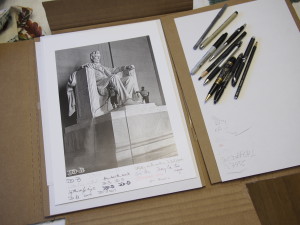
People following my blog can probably guess why I’m concerned with this just at the moment.
Where and Why
The formal purpose of the artist’s signature is to certify that particular print as meeting their artistic and technical standards.
My research strongly suggests that there is no consensus on what is expected by art buyers, collectors, or museum curators. They do all seem to like consistency, so you should decide early on what you’re going to do, and do that from then on. Or at least make rare changes, and make the changes cleanly and ideally document somewhere people can find that you have done so.
So far as I can tell, people do anything from nothing at all to using a stamp or “chop” on the back to signing the front (“recto”) or back (“verso”). They write anything from their initials to a regular signature, or print their name, or anything else. They often include a date or two (for photography, date of image and date of print are the two most often used). They sometimes include the title of the print. They use anything from metallic-ink sharpies to pencils. They write on the back, or in the margin on the front, or within the actual image.
The full form I like is to put the image title and year photographed in the bottom margin at the left, and the signature and year printed at the right. I will leave enough space so it can be either included in the mat opening, or matted out, at the owner’s choice.
However, when signing a batch of prints all at once, that’s too much to write (it is; I’m not lazy, I just have lousy handwriting, and if I tried to do that much on each of a pile of prints, it’d end up illegible on most of them). If I were clever and thought ahead more, I might print the image title and year photographed as part of the image (an image of my careful printing; I can do it once legibly if I get enough chances), and only do the actual signature and year printed by hand.
How
Specifically, with what? What writing instrument?
The requirements as I see them are:
- Harmless (will not damage the image, either physically or chemically)
- Permanent (will not fade, hard to remove, resistant to water and other hazards)
- Suitable width (artist preference)
- Suitable color / density (artist preference)
- Hard to smear
- Writes smoothly and without skipping on the particular paper
Those first two are sometimes lumped into “archival”. Given the complexity of the inkset-plus-paper chemistry encountered in modern digital inkjet prints, adding a third thing, the ink from the signing pen, to the equation is at best a wild gamble. Ink plus paper combinations get tested by various firms, but I’ve never heard of any of them adding signing pens into the mix.
Given this total lack of real information, I’m making a wild leap of faith: I’m accepting all writing implements that make claims of being permanent and (critically) neutral Ph (or acid-free). And I’m taking their word for it; I have no way to verify it much. Amateur testing is interesting as far as it goes, but accelerated testing is a black art, amateurs aren’t very good at it. And for art prints, I’m thinking in terms of the print lasting for centuries, not just years.
The totally conservative approach is to stick to pencil (graphite, not very reactive) or India ink (basically a carbon suspension in water, not very reactive). I find that too limiting, especially since pencil doesn’t write on the front of this paper.
I tried a bunch of pens I liked writing with and had sitting around on this paper. Surprisingly, everything with any sort of “ink” wrote beautifully on the particular paper I’m working with this time (Canson Baryta Photographique). One dry pencil also worked fine (the Schwan all-stabilo 8046); a mechanical pencil with HB lead and a charcoal marker didn’t mark at all. (Maybe it’s not that surprising; this paper has an ink-receptive surface layer after all.)
Even more surprisingly, every pen I looked up info on claimed to be archival and acid free; apparently all of these pens I grabbed meet my technical criteria. (Well, all but one; for total giggles I tried a Big Round Stic, a very cheap ballpoint. Surprisingly, it wrote on the paper perfectly well. It’s hard enough to damage the surface, and I have no reason to consider its ink suitably permanent, so I would strongly recommend against actually using it to sign artwork.)

The implements I tried include:
- Schwan All-Stabilo 8046 black pencil
- Sakura Pigma Micron 08 #1 archival ink pen (fine soft-point)
- Mechanical pencil with HB lead—did not write on this paper
- Pilot Precise Grip Bold (liquid ink pen)
- Uniball Signo Impact 207 RT (gel ink pen)
- Sharpie Liquid Pencil (seems to be graphite ink pen)
- Schmidt Easyflow 9000 M refill (gel ink refill)
- Sanford Sharpie fine-point permanent marker (permanent felt-tip)
- Blaisdell Charcoal Pencil Medium 633T—did not write on this paper
Results
Here are the various results. I’m not bothering to label individual trials, you’ll need to try your pens on your paper anyway, but this shows that a wide range of pens made good solid clean marks on this paper, at least.

I also tried a few of them on the back of the paper.

ADDED: I found the Sakura almost impossible to smear. The other roller pens could be smeared just slightly by running a finger over them immediately after writing—not something I do frequently by accident, but it also indicates that stacking prints as I sign them might be a problem. The Stabilo pencil also smeared a tiny bit, interestingly.
Other Interesting Articles
How To Sign Photographs part 1 part 2 part 3 part 4
